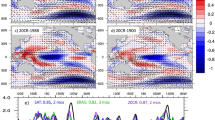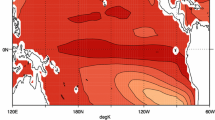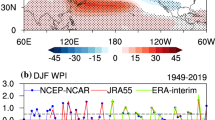Abstract
The central Pacific (CP) zonal wind divergence and convergence indices are defined, and the forming mechanism of CP El Niño (La Niña) events is discussed preliminarily. The results show that the divergence and convergence of the zonal wind anomaly (ZWA) are the key process in the forming of CP El Niño (La Niña) events. A correlation analysis between the central Pacific zonal wind divergence and convergence indices and central Pacific El Niño indices indicates that there is a remarkable lag correlation between them. The central Pacific zonal wind divergence and convergence indices can be used to predict the CP events. Based on these results, a linear regression equation is obtained to predict the CP El Niño (La Niña) events 5 months ahead.
Similar content being viewed by others
References
Ashok K, Behera S K, Rao S A, et al. 2007. El Niño Modoki and its possible teleconnection. Journal of Geophysical Research, 112(C11): C11007
Chao Jiping, Yuan Shaoyu, Chao Qingchen, et al. 2003. The origin of warm water mass in “Warm Pool” subsurface of the Western Tropical Pacific-the analysis of the 1997–1998 El Niño. Chinese Journal of Atmospheric Sciences (in Chinese), 27(2): 145–151
Chen Jinnian, He Yijun, Xu Lanying, et al. 2002. Oceanic temperature anomalous signal pathway in the subsurface of equatorial Pacific. In: Papers of the 5th Cross-strait Marine Science Seminars (in Chinese). Jilong: National Taiwan Ocean University
Chen Jinnian, Song Guiting, Chu Jianting, et al. 2003a. Anomalous sea temperature of westward transferring North Equatorial Current and ENSO. Journal of Tropical Oceanography (in Chinese), 22(4): 10–17
Chen Jinnian, Song Guiting, Chu Jianting, et al. 2003b. Oceanic temperature anomalous signal pathway in the equatorial Pacific. Advances in Water Science (in Chinese), 14(2): 152–157
Chen Jinnian, Wang Hongna, Wang Dongxiao, et al. 2011. Variational characteristics analyses of the El Niño event in 2009/2010. Acta Oceanologica Sinica (in Chinese), 33(6): 29–38
Chen Jinnian, Wang Yang, Wang Hongna, et al. 2012. The formation mechanism of the central Pacific pattern La Niña event in 2010/2011 and its anomalous vertical circulation. Advances in Marine Science (in Chinese), 30(3): 305–316
Choi J, An S II, Kug J S, et al. 2011. The role of mean state on changes in El Niño’s flavor. Climate Dynamics, 37(5–6): 1205–1215
Collins M, An S II, Cai Wenju, et al. 2010. The impact of global warming on the tropical Pacific Ocean and El Niño. Nature Geoscience, 3(6): 391–397
Fu Congbin, Fletcher. 1985. Two types of warming in the El Niño process. Science Bulletin (in Chinese), 30: 596–599
Kao H Y, Yu J Y. 2009. Contrasting eastern-Pacific and central-Pacific types of ENSO. Journal of Climate, 22(3): 615–632
Kug J S, Jin Feifei, An S II. 2009. Two types of El Niño events: cold tongue El Niño and warm pool El Niño. Journal of Climate, 22(6): 1499–1515
Larkin N K, Harrison D E. 2005. Global seasonal temperature and precipitation anomalies during El Niño autumn and winter. Geophysical Research Letters, 32(16): L16705
Li Chongyin, Mu Mingquan. 1999. El Niño occurrence and sub-surface ocean temperature anomalies in the pacific warm pool. Chinese Journal of Atmospheric Sciences (in Chinese), 23(5): 513–521
McPhaden M J, BuSalacchi A J, Anderson D L T. 2010. A TOGA Retrospective. Oceanography, 23(3): 86–103
Wittenberg A T. 2009. Are historical records sufficient to constrain ENSO simulations? Geophys Res Lett, 36(12): L12702
Xie Ruifang, Huang Fei, Ren Hongli. 2013. Subtropical air-sea interaction and development of central Pacific El Niño. Journal of Ocean University of China, 12(2): 260–271
Yu Jinyi, Kim S T. 2010. Three evolution patterns of central-Pacific El Niño. Geophys Res Lett, 37(8): L08706
Wang Chunzai, Wang Xin. 2013. Classifying El Niño Modoki I and II by different impacts on rainfall in southern China and Typhoon tracks. J Climate, 26(4): 1322–1338, doi: 10.1175/JCLID-12-00107.1
Wang Xin, Zhou Wen, Li Chongyin, et al. 2013. Comparison of the impact of two types of El Niño on tropical cyclone genesis over the South China Sea. Int J Climate, 34(8): 2651–2660
Wang Yang, Chen Jinnian, Wang Hongna. 2013. Distribution of the tropical Pacific surface zonal wind anomaly and its relation with two types of El Niño. Chinese Journal of Oceanology and Limnology, 31(5): 1137–1152
Author information
Authors and Affiliations
Corresponding author
Additional information
Foundation item: The National Basic Research Program (973 Program) of China under contract No. 2012CB417402; the Strategic Priority Research Program of the Chinese Academy of Sciences under contract No. XDA11010102.
Rights and permissions
About this article
Cite this article
Zuo, T., Chen, J. & Wang, H. Impact of the central Pacific zonal wind divergence and convergence on the central Pacific El Niño event. Acta Oceanol. Sin. 33, 85–89 (2014). https://doi.org/10.1007/s13131-014-0497-3
Received:
Accepted:
Published:
Issue Date:
DOI: https://doi.org/10.1007/s13131-014-0497-3




